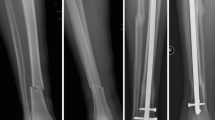Abstract
Fracture stabilization and reduction using temporary plates during intramedullary tibial nailing was introduced as a novel concept in fracture surgery by Benirschke et al. (Orthop Trans 18:1055–1056, 1995). The concept of temporary reduction using one-third tubular plates proved useful in aiding metaphyseal and periarticular fracture fixation also. However, planning the strategic location of final plate was the main limitation with this technique using one-third tubular plates. We used 2.0 mini plates as provisional reduction plates that solved the issue of planning and placement of plates. The main advantage of our technique is that the final definitive plate can be applied directly over the mini plates. Here, we will describe our technique using relevant fracture case in metaphyseal–periarticular location.



Similar content being viewed by others
References
Benirschke S, Henley M, Ott J (1995) Proximal one-third tibial fracture solutions. Orthop Trans 18:1055–1056
Freedman EL, Johnson EE (1995) Radiographic analysis of tibial fracture malalignment following intramedullary nailing. Clin Orthop Relat Res 25–33
Lang GJ, Cohen BE, Bosse MJ, Kellam JF (1995) Proximal third tibial shaft fractures. Should they be nailed? Clin Orthop Relat Res 64–74
Archdeacon MT, Wyrick JD (2006) Reduction plating for provisional fracture fixation. J Orthop Trauma 20:206–211
Stover MD, Kellam JF (2007) Articular fractures: principles. In: Ruedi TP, Buckley RE, Morgan CG (eds) AO principles of fracture management. Thieme, New York, p 148
Mouhsine E, Akiki A, Castagna A et al (2007) Transolecranon anterior fracture dislocation. J Shoulder Elbow Surg 16:352–357
Hessmann MH, Ring DC (2007) Humerus, distal. In: Ruedi TP, Buckley RE, Morgan CG (eds) AO principles of fracture management. Thieme, New York, p 616
Chapman MW (1993) Operative Orthopaedics. In: Madision M (ed) Operative orthopaedics. Lippincott Williams & Williams, Philadelphia, p 330
Mast J, Jakob R, Ganz R (1989) Planning and reduction tool in fracture surgery. Springer, Heidelberg
Author information
Authors and Affiliations
Corresponding author
Rights and permissions
About this article
Cite this article
Oh, JK., Sahu, D., Park, JW. et al. Use of 2.0 mini plate system as reduction plate. Arch Orthop Trauma Surg 130, 1239–1242 (2010). https://doi.org/10.1007/s00402-009-1008-4
Received:
Published:
Issue Date:
DOI: https://doi.org/10.1007/s00402-009-1008-4




